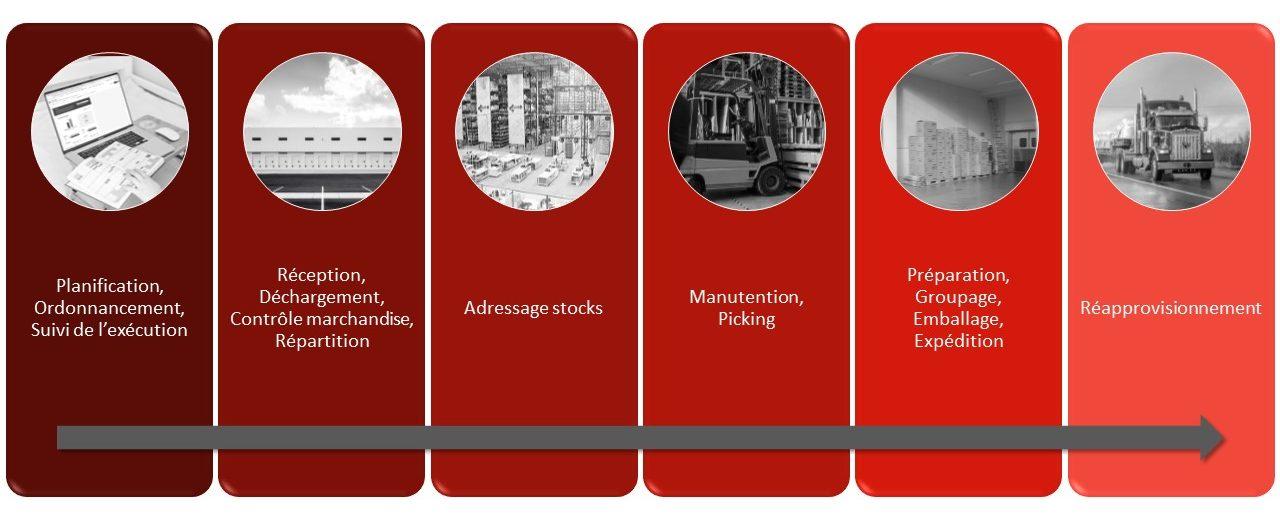
When new challenges arise, access to expertise and experience is crucial to making the right decisions and channeling investments into areas that will bring value.”
Whatever your business challenges or drivers for change, ALOER can help you optimize your operations and warehousing space.
WMS (Warehouse Management System) software has rapidly won over the retail and e‑commerce sectors. More and more companies, including SMEs, are adopting them to effectively manage their supply chain and differentiate themselves from the competition.
Warehouse management systems are designed :
- to guarantee better visibility of inventory,
- to optimize order management and labor,
- and guarantee optimal order execution.
Would you like to improve your logistics organization and enhance service quality? ALOER supports you from the design of your warehouse to the implementation of your WMS solution.
WMS software, a powerful logistics tool
Logisticians are wont to say that“the WMS is the ERP (Enterprise Resource Planning) of the warehouse”.
Well-optimized logistics is a serious competitive advantage for a company: the WMS reduces direct operating costs andincreases overall revenue.
WMS software is a powerful tool for improving industrial performance by optimizing warehouse management:
- cost reduction,
- process rationalization,
- improving service quality…
Warehouse Management System software: definition
Supply Chain Management (SCM) consists of 2 parts:
- Supply Chain Planning (SCP)
- Supply ChainExecution (SCE)
The WMS - Warehouse Management System - is part of the execution strategies (SCE) in the Supply Chain.
The WMS manages warehouse operations. In other words, this type of software manages resources and stock within the 4 walls of a warehouse, and sometimes even off-site inventory.
WMS solutions are available as Software as a Service (Saas) or on-premise, depending on the vendor.
In short, the WMS is a business software that ensures optimal management of a logistics warehouse by facilitating the coordination, control and optimization of flows and floor space.
How does WMS software work to manage your warehouses?
“Stock accuracy can be improved to over 99%, while reducing inventory by up to 20%.”
WMS software gives you an overview of your inventory and related activities. It works by controlling all inventory movements and automating all redundant tasks in the goods-in and goods-out processes.
And in particular, inorder of flow:

WMS software contains a number of basic functions:
- item, batch and packaging management
- management of zones, aisles, racks or locations
- traceability
- alerts
- reporting and overview of operations
Certain add-on modules can also be added. For example:
- for the storage of hazardous materials,
- or to enable the management of mechanized or automated stock management tools.
What are the advantages of a WMS?
Implementing warehouse management software offers advantages and productivity gains such as :
- time savings thanks to task automation
- faster order processing for improved customer service
- optimized use of warehouse space, thanks to simulations
- improved work and operator productivity
- real-time stock control,
- fewer errors and less fraud
- overall warehouse productivity and reduced cycle times
- greater visibility and traceability
- scrap reduction
- data centralization
“With the WMS, boost perfect order rates, increase labor productivity by up to 40% and refine shipment accuracy by up to 5%.”
A WMS supports logistics activities in the following context:
- Large number of storage locations
- Receive and process more lines but fewer items per order
- Large number of orders
- Single-item orders
- Large number of items available
- Large number of delivery points
- Large number of returns
- Volume fluctuations
- Short lead times
- Multiple sales channels
- Local and international orders
- High number of daily samples
- Shorter order cycle times
- Systematic unit packaging
- Different packing instructions
- High value-added services
- Documentation in different languages
- Loading parcels
How do you set up a WMS for your company’s logistics?
While streamlining your warehouse operations can increase productivity, the potential teething problems with a new WMS system can be considerable, as with any new management software package. All the more so when it’s strategic to retain ownership of your logistics.
Before implementing a WMS, there are several steps to be taken:
As with any consideration of a new addition to your information system, you’ll need to draw up a set of specifications to enable you to study the solutions available on the market.
It’s really interesting tostudy the areas for improvement in the warehouse via a design review. All the more so if you plan toadd mechanical or automatic means to support your logistics activities (Kardex, OHRA, RACK Concept, HUNI …).
Adapting your warehousing strategy at the same time as installing a WMS can be a good way of overhauling your existing flows and processes. This is an opportunity to maximize the benefits of WMS installation. It also means you can adapt to the standard WMS framework, rather than having to engage in specific developments and laborious workarounds.
ALOER supports your organization from start to finish in overcoming these obstacles, thanks to its expertise in warehousing and its advanced warehouse management software, Infor CloudSuite WMS.
Can WMS software and ERP be synchronized?
First of all, some ERPs offer a warehouse management module. The same applies to e‑commerce software such as Magento or Prestashop.
The use of warehouse management software is essential when logistics execution functions are either absent or too basic and therefore limited.
WMS systems do not operate in isolation from other systems. A connection must be established between the ERP and the WMS, as well as with other IT tools and solutions/applications:
- barcode scanning,
- augmented reality,
- transport management systems — TMS
- enterprise resource planning systems… etc
Some WMS software on the market synchronizes with these same solutions via EDI (Electronic Data Interchange) or, more widely, API (Application Programming Interface).
Before selecting your WMS warehouse management software, we strongly advise you to check that interface systems exist with your tools.
“Every organization and its warehouse strives for perfect order fulfillment, i.e. the delivery of a customer order in the quantities requested, on time and with optimum efficiency. The addition of a WMS to your IT ecosystem enables you to be more efficient, with increased visibility, flexibility and scalability for greater order accuracy, productivity and ROI..”
The combination of WMS + ERP ensures high levels of performance if the software is correctly parameterized and matched to the needs of your business.
Any doubts? We can help.
What are the differences between WMS and TMS software?
Unlike the WMS, the TMS or Transport Management System software is a tool dedicated to transport management. The TMS manages delivery traceability and transport optimization in real time.
The software TMS software is often connected to the WMS software. In fact, its functionalities complement those of warehouse management. It also enables :
- organizing loading and delivery schedules,
- optimized management of transport vehicles,
- tracking goods as they leave the warehouse,
- all transport billing processes,
- decision support.
In this way, the TMS extends the traceability and organization of delivery flows beyond the warehouse, the traceability and organization of delivery flows .
How to choose the right WMS software to manage your warehouses?
The WMS market is quite dynamic, with a host of innovations.
There’s no point going fishing (for WMS) without a minimum of upstream preparation: we suggest a few ideas and 16 questions to ask yourself before starting your search for solutions.

A number of criteria will be used to compare and choose from the market’s offerings, and then determine which WMS is best suited to your business constraints.
In addition to drawing up your specifications, here are a few points to check:
- Where are the shortlisted WMS for your sector?
- Size of warehouse to be equipped?
- How do you interface with your ERP?
- How do you maintain and upgrade your solution?
- The cost of the solution?
It’s also a good idea to ask yourself the following questions ahead of time:
- Have you drawn up a process design for your warehouse?
- Do you have a clear strategy for your supply chain and your technological needs (information systems communicating in real time, PLCs, connected objects, RFID, etc.)?
- Have you carried out a gap analysis (current business performance vs. desired performance)?
- Have you carried out a return on investment ( ROI ) analysis with the support of specialists or an expert WMS consultant?
- Have you trained the project team? Does it include warehouse managers, operational team resources, IT, finance, sales…?
- Have you chosen a committed, meticulous project manager?
- Is your project sponsor a DG-level manager?
- Is your team trained in WMS? Does it know how to evaluate the available functionalities of these solutions?
- Have you studied how the implementation will be carried out?
- Have you secured thecommitment of shareholders/CEOs?
- Do you plan to support your operators through support?
If you can’t answer all these questions, it will certainly be in your interest to consult a WMS expert to ensure the future viability and performance of your warehouse.
Reasons for WMS project failures
The choice of software is a strategic one for any organization.
To avoid making the wrong investment or investing too much, it’s important to pay attention to certain details.
Above all , it’sbest to “stick to the software standard” to avoid the extra cost of specific (sometimes unnecessary) developments.
The most common pitfalls include :
- A project team lacking experience in project management
- Lack of authority of project managers responsible for dates and budget
- Insufficient resources with the required skills
- The absence of a structured methodology for reconciling resource commitments to different projects
- The diktat of internal policies and short-term requirements
What are the most popular WMSs?
There are almosta hundred WMS solutions on the market.
The choice will take into account the size of the company, its activity, the desired functionalities and its own growth prospects.
Solutions can be divided into 3 categories:
- All-in-one” vendors: these are actually ERP vendors. The latter have expanded their range of modules over the years to include WMS modules: this is the case for SAP, Cegid, Generix Infolog, …
- Supply Chain Execution specialists: supply chain and logistics specialists, these publishers offer comprehensive, rich and specialized solutions: Acteos, Hardis, Infor Cloudsuite WMS, WMSReflex, Manhattan, KLS Logistic, Infflux, stock-IT, etc.
- Warehouse equipment manufacturers : suppliers of mechanization and automation solutions. The latter have developed WMS solutions after their core business. These solutions integrate easily with their tools: Savoye, Mecalux, BK System…
Infor Cloud Suite WMS
Infor CloudSuite™ WMS (formerly Infor SCE) is a Gartner* Magic Quadrant 2022 Leader in Warehouse Management Systems.
Deployed in nearly 60 countries, it combines basic and advanced WMS functionality with workforce/HR management, and supports B2B and B2C order fulfillment. This means greater precision, productivity and flexibility for your orders. Our presence in numerous warehouses around the world means that we can continue to develop this specialized software in line with best practice.
Infor CloudSuite WMS enables companies to manage the activities of their distribution centers on a global scale. This solution combines warehouse order fulfillment, workforce management and 3D visualization.
As a result, it reduces process complexity and improves operational execution. Configurable and intuitive, the CloudSuite WMS solution is ready to support all new-generation warehouse operations on an international scale, boosted by cutting-edge technology.
*Gartner is a consulting and research firm in the field of advanced technology, which publishes the results of its research every year in the form of company, solution or product comparisons.
The benefits of Infor Cloud Suite WMS
Infor CloudSuite™ WMS is one of the international leaders.
The solution provides a range of functions to improvewarehouse efficiency and ROI for its customers:
- reduced personnel and transport costs, as well as CO2 emissions
- the breeding ground for expanding your company’s service offering and growing your customer base
- increase the performance of your logistics operations
- increase your margins
